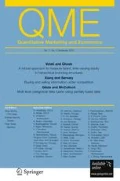Abstract
Market share models for weekly store-level data are useful to understand competitive structures by delivering own and cross price elasticities. These models can however not be used to examine which brands lose share to which brands during a specific period of time. It is for this purpose that we propose a new model, which does allow for such an examination. We illustrate the model for two product categories in two markets, and we provide share-switching estimates. We also demonstrate how our model can be used to decompose own and cross price elasticities.
Similar content being viewed by others
References
Allenby, G.M. and P.E. Rossi. (1991). “Quality Perceptions and Asymmetric Switching Between Brands.” Marketing Science 10(3), 185–204.
Bell, D.E., R.L. Keeney, and J.D.C. Little. (1975). “A Market Share Theorem.” Journal of Marketing Research 12(May), 136–141.
Ben-Akiva, M. and S.R. Lerman. (1985). Discrete Choice Analysis. Cambridge, MA: MIT Press.
Berry, S., J. Levinsohn, and A. Pakes. (1995). “Automobile Prices in Market Equilibrium.” Econometrica 63(July), 841–890.
Blattberg, R.C., R. Briesch, and E.J. Fox. (1995). “How Promotions Work.” Marketing Science 14(3), G122–G132.
Blattberg, R.C. and K.J. Wisniewski. (1989). “Price-Induced Patterns of Competition.” Marketing Science 8(4), 291–309.
Brodie, R. and C.A. De Kluyver. (1984). “Attraction Versus Linear and Multiplicative Market Share Models: An Empirical Evaluation.” Journal of Marketing Research 11(May), 194–201.
Bronnenberg, B.J. and L. Wathieu. (1996). “Asymmetric Promotion Effects and Brand Positioning.” Marketing Science 15(4), 379–394.
Bucklin, R.E. and J.M. Lattin, (1991). “A Two-State Model of Purchase Incidence and Brand Choice.” Marketing Science 10(1), 24–39.
Bucklin, R.E., G.J. Russell, and V. Srinivasan. (1998). “A Relationship Between Market Share Elasticities and Brand Switching Probabilities.” Journal of Marketing Research 35(February), 99–113.
Che, H., P.B. Seetharaman, and K. Sudhir. (2003). “Pricing Behavior in Markets with State Dependence in Demand.” Working paper.
Chen, Y., V. Kanetkar, and D.L. Weiss. (1994). “Forecasting Market Shares with Disaggregate or Pooled Data: A Comparison of Attraction Models.” International Journal of Forecasting 10, 263–276.
Chintagunta, P.K. (2000). “A Flexible Aggregate Logit Demand Model.” Working paper, University of Chicago.
Cooper, L.G. (1993). “Market-Share Models.” In J. Eliashberg and G.L. Lilien (eds.), Handbooks in Operations Research and Management Science Vol. 5, Elsevier Science Publishers.
Cooper, L.G. and M. Nakanishi. (1988). Market Share Analysis: Evaluating Competitive Marketing Effectiveness. Kluwer Academic Publishers.
Doornik, J.A. (1998). Object-Oriented Matrix Programming using Ox 2.0. Timberlake Consultants, London, http://www.nuff.ox.ac.uk/Users/Doornik.
Fok, D., P.H. Franses, and R. Paap. (2002). “Econometric Analysis of the Market Share Attraction Model.” In P.H. Franses and A.L. Montgomery (eds.), Advances in Econometrics Vol. 16: Econometric Models in Marketing. Elsevier Science Publishers.
Givon, M. (1984). “Variety Seeking Through Brand Switching.” Marketing Science 3(1), 1–22.
Guadagni, P.M. and J.D.C. Little (1983). “A Logit Model of Brand Choice Calibrated on Scanner Data.” Marketing Science 2(3), 203–238.
Gupta, S. (1988). “Impact of Sales Promotions on When, What, and How Much to Buy.” Journal of Marketing Research 25(November), 342–355.
Gupta, S., P. Chintagunta, A. Kaul, and D.R. Wittink. (1996). “Do Household Scanner Data Provide Representative Inferences From Brand Choices: A Comparison With Store Data.” Journal of Marketing Research 33(November), 383–398.
Hamilton, J.D. (1994). Time Series Analysis. Princeton University Press.
Hardie, B.G.S., E.J. Johnson, and P.S. Fader. (1993). “Modeling Loss Aversion and Reference Dependence Effects on Brand Choice.” Marketing Science 12(4), 378–394.
Kamakura, W.A. and G.J. Russell. (1989). “A Probabilistic Choice Model for Market Segmentation and Elasticity Structure.” Journal of Marketing Research 26(November), 379–390.
Kumar, V. and T.B. Heath. (1990). “A Comparative Study of Market Share Models Using Disaggregate Data.” International Journal of Forecasting 6, 163–174.
Lal, R. and V. Padmanabhan. (1995). “Competitive Response and Equilibria.” Marketing Science 14(3), G101–G108.
Lattin, J.M. and L. McAlister. (1985). “Using a Variety-Seeking Model to Identify Substitute and Complementary Relationships Among Competing Products.” Journal of Marketing Research 22(August), 330–339.
Leeflang, P.S.H. (1974). Mathematical Models in Marketing. Stenfert Kroese, Leiden.
Leeflang, P.S.H., D.R. Wittink, M. Wedel, and P.A. Naert. (2000), Building Models for Marketing Decisions. Kluwer Academic Publishers.
McAlister, L. and E. Pessemier, (1982). “Variety Seeking Behavior: An Interdisciplinary Review.” Journal of Consumer Research 9(December), 311–322.
McFadden, D. (1974). “Conditional Logit Analysis of Qualitative Choice Behavior.” In P. Zarembka (ed.), Frontiers in Econometrics, Chapter 4, Academic Press.
Naert, P.A. and M. Weverbergh. (1981). “On the Prediction Power of Market Share Attraction Models.” Journal of Marketing Research 18(May), 146–153.
Russell, G.J. and W.A. Kamakura. (1994). “Understanding Brand Competition Using Micro and Macro Scanner Data.” Journal of Marketing Research 31(May), 289–303.
Seetharaman, P.B. and P. Chintagunta. (1998). “A Model of Inertia and Variety-Seeking with Marketing Variables.” International Journal of Research in Marketing 15, 1–17.
Sethuraman, R., V. Srinivasan, and D. Kim. (1999). “Asymmetric and Neighborhood Cross-Price Effects: Some Empirical Generalizations.” Marketing Science 18(1), 23–41.
Van Heerde, H.J., S. Gupta, and D.R. Wittink, (2002). “Is 3/4 of the Sales Promotion Bump Due to Brand Switching? No, it is 1/3.” Journal of Marketing Research forthcoming.
Villas-Boas, J.M. and R.S. Winer. (1999). “Endogeneity in Brand Choice Models.” Management Science 45(October), 1324–1338.
Author information
Authors and Affiliations
Corresponding author
Additional information
JEL Classification: C10, C51, C53, M31
Rights and permissions
About this article
Cite this article
van Oest, R. Which Brands Gain Share from Which Brands? Inference from Store-Level Scanner Data. Quant Market Econ 3, 281–304 (2005). https://doi.org/10.1007/s11129-005-0302-x
Issue Date:
DOI: https://doi.org/10.1007/s11129-005-0302-x




